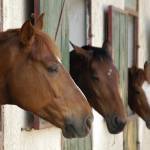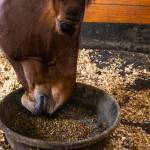Gastric Ulcers in Horses: Facts and Fallacies

A recent web-based survey queried horse owners on their knowledge and familiarity with equine gastric ulcer syndrome (EGUS). Based on over 1,100 responses from individuals with and without direct experience with EGUS, here is a summary of what horse owners know, and perhaps more importantly, don’t know about gastric ulcers in horses.
Survey respondents indicated that EGUS most commonly occurs in racehorses followed by sport horses. Leisure horses were perceived as only rarely affected.
Fact or fallacy? Both, actually. All horses are at risk of developing EGUS, but some horses may have an increased risk based on diet, water intake, lifestyle (use, training level), breed, concomitant diseases, and more.
Horse owners who have prior experience with ulcers were more aware that multiple types of ulcers exist.
Fact. EGUS is an umbrella term that collectively refers to ulcers (erosions in the lining of the stomach wall) that occur in either (1) the squamous or nonglandular region of the stomach, where ulcer presence is called equine squamous gastric disease (ESGD) or (2) the glandular region, where ulcer formation is considered equine glandular gastric disease (EGGD). Some horses can even suffer from EGGD and ESGD simultaneously.
Low forage intake and infection were identified as the most common factors associated with EGUS by survey respondents.
Fact and fallacy. Based on a recently published consensus statement on EGUS, a high-starch diet was more reliably a predictor of EGUS than low forage intake.** Those experts wrote that “free access to fibrous feed or frequent forage feeding is widely considered to reduce the risk of gastric ulceration, although strong evidence supporting this belief is also lacking.” That said, to be on the safe side, all horses should get 1.5 to 2% of their body weight in forage daily for overall digestive health and motility. If free-choice access to forage is not suitable for certain horses or is not possible in some management scenarios, horses should go no longer than four or five hours between forage meals.
No specific mention of infection as a risk factor for EGUS was discussed in the consensus statement. Infection causing decreased feed intake, delayed gastric emptying, or stress could potentially contribute to the development of gastric ulcers. Helicobacter pylori infection does not cause ulcers in horses, as it does in humans. The latest consensus statement on EGUS clearly states that antibiotic administration is not justified.
Reliable signs of gastric ulceration identified by horse owners included change in behavior when fed, aggression, anemia, low white blood cell counts, and changes in behavior when ridden. Interestingly, respondents with prior experience felt that clinical signs could effectively diagnose EGUS, whereas individuals with no direct experience felt clinical signs were only moderately effective at diagnosing the condition.
Fact. As described by the EGUS expert panel, “Gastric ulcers have been loosely associated with a range of clinical signs in adult horses, despite a paucity of strong epidemiological evidence to support these associations.”
Such clinical signs include decreased appetite, poor body condition, weight loss, chronic diarrhea, poor coat condition, grinding teeth, behavioral changes, acute or recurrent colic, and poor performance.
The best method of diagnosing EGUS by a veterinarian is gastroscopy.
Fact. The expert panel wrote that, because EGUS is poorly associated with clinical signs, “the committee therefore does not support the practice of diagnosing EGUS based on ‘characteristic’ clinical signs and recommends that EGUS be confirmed by performing gastroscopy.”
Both groups of respondents recognized omeprazole as an effective treatment.
Fact. Omeprazole blocks the production of gastric acid (hydrogen chloride) and increases the pH of the fluid in the stomach. This is in line with human ulcer treatments where the adage “no acid, no ulcer” is widely embraced. The horse should undergo follow-up gastroscopy prior to discontinuing treatment to ensure full healing. This is particularly true for EGGD because resolution takes longer than ESGD.
Sucralfate was recognized as another effective treatment by individuals with prior experience with EGUS but was unknown by those without experience.
Fact. According to experts, sucralfate should be used in conjunction with omeprazole to treat EGUS. The recommended dose is 12 mg/kg orally twice daily for 8 weeks. The proposed mechanisms of action of sucralfate include: adhering to ulcerated mucosa to protect damaged, healing tissues; stimulating mucous secretion and prostaglandin E synthesis, both of which protect the lining of the stomach); and enhancing blood flow. In Australia, horse owners should look for the sucralfate supplement Sucralox.
“A great deal of information regarding EGUS has been uncovered in the past 20 years. Failing to quickly identify EGUS in horses or inappropriately managing horses with EGUS and without the support of their veterinarian will delay appropriate treatment and potentially culminate in adverse outcomes,” said Catherine Whitehouse, M.S., a Kentucky Equine Research nutrition advisor. “Once a veterinarian has diagnosed EGUS, omeprazole treatment should be implemented.”
Digestive buffers such as RiteTrac and Triacton can be used to support gastric health prophylactically or following treatment with omeprazole. RiteTrac has fast-acting antacids and coating agents to quickly neutralize excessive gastric acid, protect the stomach lining, and restore the normal gastric environment. Triacton contains a research-proven stomach buffer, which reduces acidity and decreases the likelihood of gastric ulcer formation.
*Marlin, D.J., J. Williams, K. Pickles, et al. 2019. Horse owner understanding of equine gastric ulcer syndrome (EGUS). Journal of Equine Veterinary Science. 76:55.
**Sykes, B.W., M. Hewetson, R.J. Hepburn, et al. 2015. European College of Equine Internal Medicine Consensus Statement—Equine gastric ulcer syndrome in adult horses. Journal of Veterinary Internal Medicine. 29(5):1288–1299.








